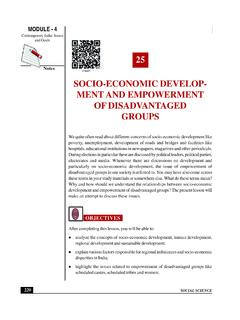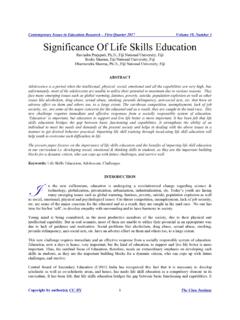Transcription of Storytelling - ADB
1 Knowledge SolutionsOctober 2008 | 10 Storytelling is the use of stories or narratives as a communication tool to value, share, and capitalize on the knowledge of Olivier Serrat DefinitionStorytelling is the vivid description of ideas, beliefs, personal experiences, and life- lessons through stories or narratives that evoke powerful emotions and has advantages over the communication tech-niques commonly used in organizations, be they electronic mail, reports, or formal speeches. First, it enables articula-tion of emotional aspects as well as factual content, allow-ing expression of tacit knowledge (that is always difficult to convey).
2 Second, by providing the broader context in which knowledge arises, it increases the potential for meaningful knowledge-sharing. Third, by grounding facts in a narrative structure, it augments the likelihood that learning will take place and be passed on. Pur-poseful Storytelling can deliver results that conventional, abstract modes of communica-tions such as those mentioned earlier cannot. Anyone can use it and become better at using it to reach many NaturallyThe age-old practice of Storytelling is one of the most effective tools that people can use.
3 Storytellers communicate naturally: analysis might excite the mind but it does not offer an easy route to the heart, which is where one must go to motivate people. Working with stories is one of the best ways to Make abstract concepts meaningful. Help connect people and ideas. Inspire imagination and motivate action. Give breathing space and allow different perspectives to emerge. Create sense, coherence, and meaning. Develop valuable descriptions of the situations in which knowledge is applied and solutions are found. Examine organizational values and culture.
4 Communicate complex messages simply. Operate effectively in networks. Inspire Solutions2 Table 1: The Difference Between a Report and a Story Version AVersion BIn our evaluation of a project in Bangladesh, we noted a wide variance in the competence of individual villages to develop sustainable and effective solutions to problems encountered, for example in replacing broken parts or developing low-cost products such as new latrines. The lessons to be learned from this evaluation are that we should: work against over-dependence on development partners, note and encourage entrepreneurial approaches to problems, identify existing and repeatable good practices, build and strengthen communication between villages to assist cross-fertilization of ideas at the grassroots is a really impressive in a positive sense.
5 I was in a village last year working in water and sanitation. We were trying to promote the use of improved latrines, but could not produce concrete slabs and rings locally for a low cost. Somebody told me to visit the latrines of a lady in the village, so I went along and said, Can I see your latrines? She had made a latrine out of a clay pot with the bottom cut off. Then, with a potter from the area, she developed a small local production of bottomless pots, and they became the latrines. few weeks later I was in another village and saw a hand pump; it was broken, just a small piece missing.
6 So I said to the villagers, Why don t you repair your pump? And they said, Oh, we just wait for another donor to bring a new pump. So I said, Why don t you visit the lady in the village over there? She finds ways of getting things done for herself. Source: Swiss Agency for Development and Cooperation. 2005. Story Guide: Building Bridges Using Narrative Techniques. Berne. Available: 2: A Storytelling Catalogue If your objective is to You will need a story thatIn telling it, you will need toYour story will inspire such responses asSpark actionDescribes how a successful change was implemented in the past, but allows listeners to imagine how it might work in their situationAvoid excessive detail that will take the audience s mind off its own challenge Just What Communicate who you areProvides audience-engaging drama and reveals some strength or vulnerability from your pastInclude meaningful details.
7 But also make sure the audience has the time and inclination to hear your story I didn t know that about him! Now I see what she s driving at. Transmit valuesFeels familiar to the audience and will prompt discussion about the issues raised by the value being promotedUse believable (though perhaps hypothetical) characters and situations, and never forget that the story must be consistent with your own actions That s so right! Why don t we do that all the time? Foster collaborationMovingly recounts a situation that listeners have also experienced and that prompts them to share their own stories about the topicEnsure that a set agenda does not squelch this swapping of stories and that you have an action plan ready to tap the energy unleashed by this narrative chain reaction That reminds me of the time that Hey, I ve got a story like that.
8 Tame the grapevineHighlights, often through the use of gentle humor, some aspect of a rumor that reveals it to be untrue or unlikelyAvoid the temptation to be mean-spirited, and be sure that the rumor is indeed false No kidding! I d never thought about it like that before! Share knowledgeFocuses on mistakes made and shows in some detail how they were corrected, with an explanation of why the solution workedSolicit alternative and possibly better solutions There but for the grace of God .. Wow! We d better watch that from now on. Lead people into the futureEvokes the future you want to create without providing excessive detail that will only turn out to be wrongBe sure of your Storytelling skills (otherwise, use a story in which the past can serve as a springboard to the future) When do we start?
9 Let s do it! Source: Steven Denning. 2004. Telling Tales. Harvard Business Review. May: 122 129. Available: 3: Storytelling Template for Use in Workshops The Title of the Story:The Name of the Original Teller:The Name of the Listener or Understander:Landscape: The scene in time (year) and space (country)Dwelling Place:The precise location where the action occurredCharacters:The cast list, descriptive attributes, and roles in storyChallenge:The problem or task that triggered the actionAction:The sequence of events before, during, and after the turning pointThe Turning Point:The moment when the change happenedResolution.
10 The ending, including the moral, lesson learned, or message Key Visual Hooks:Mnemonics to help partners re-tell the storySource: Adapted from Sparknow Consulting. Available: is used to identify and exchange learning episodes, explore values and inspire people toward the possibility of change, enrich quantitative information with qualitative evidence, make out connections and create common purpose, and improve the effectiveness of strategic decisions. Potential applications of stories include Oral histories Team or community-building exercises Workshop warm-ups Back-to-office reports Activity or project reviews Monitoring and evaluation systems RecreationElements of a Good StoryGood stories are generally interesting, unusual, provocative, serious, controversial, surprising, intriguing, or inspiring.












